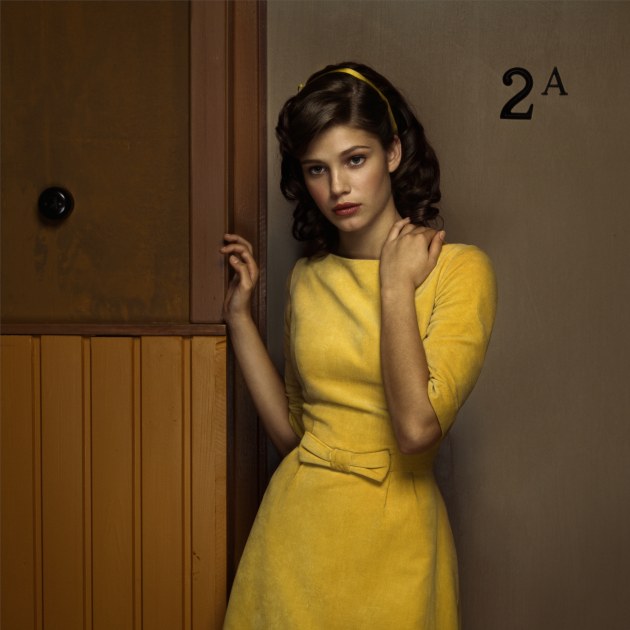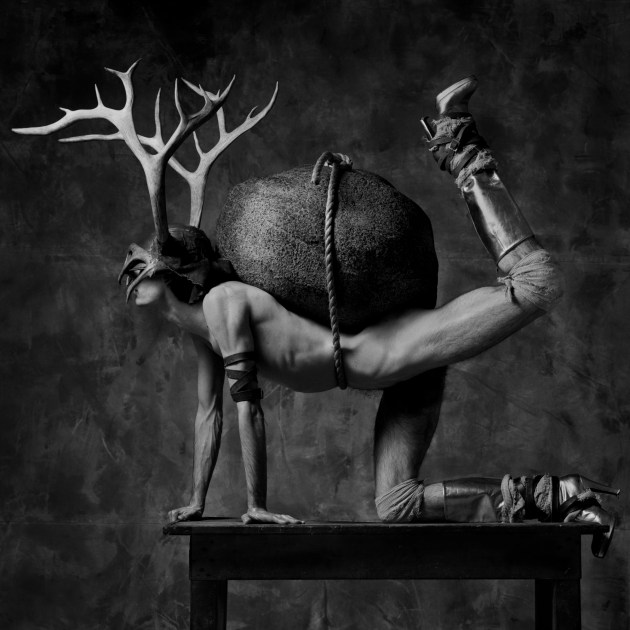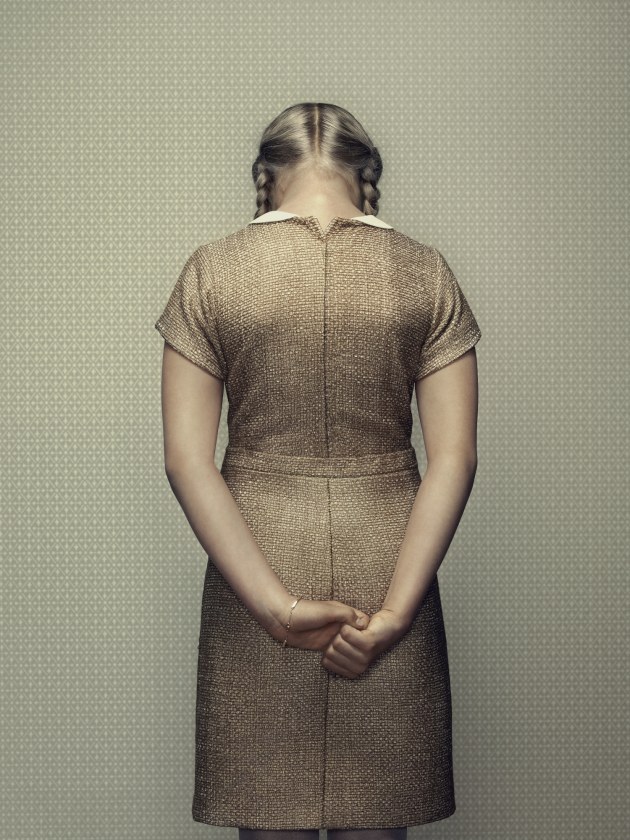Erwin Olaf – living the dream
This is the story of a provocative observer of the world and the people who don’t always make the best of it. It’s the story of photographer, Erwin Olaf. Candide McDonald meets a truly amazing person.
So many words have been written to try and describe Dutch photographic artist, Erwin Olaf’s work – his “highly-polished, precise and atmospheric visual style,” his emphasis on precision (“painterly lighting, flawless hair and make-up, settings that create an allure of serenity”), “his highly theatrical compositions…complex and dramatic narratives,” “cinematic interpretation of photography,” “incredibly-powerful and expressive tableaux,” and “nuanced vision”.

If you ask Olaf to describe his work, his answer is far simpler. “I’m a stage photographer,” he says. “I use photography to stage my own fantasies, my own dream world. As a boy, I dreamt a lot. I like to create a world that doesn’t exist.” Many of Olaf’s photographic fantasies have a purpose. “Most of the time, I am trying to tell a story. It’s a fantasy combined with a standard of technique I want to impart, but also a political view, although I don’t like protest photography. When my subject is what is worrying me, what is keeping me busy in my head, my work is best. When I create my own work and am not working for someone else, I have to express who I am and what is moving me, combined with a story that is attractive, not just for me.”
And while the technical prowess of Olaf’s work continues to ignite conversations, technique is not the photographer’s guiding light. “As a photographer, I use one technique. I’m not a technical photographer, although I think that technique is very important. The viewer should forget what technique the photographer is using. They should always see what you are meaning, what you are wanting to say.”

A photographer by chance
Olaf had originally planned to have a career in photojournalism, which he began studying at the Utrecht School of Journalism. But the writing aspects of the course challenged him. “The technique of writing, I think, is very difficult because it’s never-ending. You can change and change and change. In those days [1979] in photographs, you defaulted to film. You printed to create, you printed to darken – but at a certain point that was it.” The young man, from a small village called Hilversum in the Netherlands, was also struggling in a school that was “far too liberal” for him, he says – a hint, perhaps, that the beginning of Olaf’s personal and professional exploration of human sexuality had begun here. Then, one of the photography teachers asked him to join his class. “And he gave me a Nikon FM, the camera at the time,” Olaf recalls. “I loved the weight of it, its material. It was a love affair from the start. And then I felt love again the first time in the darkroom, being disappointed at my result, but also wowed.”
The pivot, on which Olaf turned to become the photographer he is, was a class assignment to photograph what was not normal. “Next to the city where I was living, there was an institution for people who were mentally disabled. I went there for about a week, and because I came from this little village, this visit was an awakening. There was love. There was hate, there were fights…every emotion that normal people have. And although my photographs weren’t good enough, it opened up my abilities and understanding of my craft. Meanwhile, I was educated that there was more under the rainbow than normal people, and I am still thankful for that.”

Sexual awakening
In 1988, Olaf won the Young European Photographer of the Year Award, in Germany, for his first series, Chessmen – a collection of images of “imperfect” models, bizarrely styled to resemble chess pieces. They are both grotesque and beautiful, and overlaid with an erotic suggestion that runs through all of Olaf’s early work.
Olaf had become a volunteer for the gay movement because, he says, there was a huge amount of unemployment in the beginning of the eighties, so there was absolutely no work. This gave him access to a world he had not yet encountered, but would ultimately shape his entire future. “So there was an editor in one magazine, and then an editor in another magazine, and they started to give me work because they thought my photographs were interesting. Then for one assignment I had to photograph classical ballet choreographer, Hans van Manen. He was very interested in art and photography and did photography himself. He was a friend of Robert Mapplethorpe and his technique was based on Mapplethorpe’s – the Hasselblad, the black-and-white. He had his own darkroom and taught me, not journalistic printing which is stronger, with a different composition within the image, but the style that I would come to take on.” Hans van Manen became a mentor. And Mapplethorpe inspired much of Olaf’s early work.
Olaf’s self-portraits began in the eighties. He had been working on a series called Squares, in which he’d asked a lot of people to pose nude for him. “It was very common, very normal to express yourself with the human body then. I’m still super-intrigued by the human body – all sizes and forms. And by the human skin, which is a fantastic photographic subject, the way skin has light and shadow,” he notes. “I began to feel guilty because so many people were doing things in front of the camera for me and I was always behind it. So, I thought I would make up for it a little bit and also do something in front of the camera for once. It began with a double portrait of me and my boyfriend at the time, and then an extreme close-up of my face all punk – it was the punk era. Later, it became a way to overcome my own fears and frustrations. One photograph that is very dear to me is the self-portrait triptych, I wish, I am, I will be.” Olaf has congenital emphysema and it’s a progressive disease. “It’s confronting, but I took that portrait, nearly ten years ago because it gave me closure when I started to feel the impact of it. Before that, my emphysema was kind of an abstract thing, something my doctor had told me. It worked like a therapy. It gave me acceptance.”
Squares is also an exploration of Olaf’s fears about sex. “You experiment and you think, ‘Oh, where am I?, ‘Do I dare?’ and ‘Beautiful boys are so scary,’ so I made a joke with them, like the boy with the frothing champagne bottle.”

Fantasies and self-exploration
In the 2000s, Olaf’s emotional state became the focus for his fantasies. The trilogy, Grief, Hope, and Rain, came from there. “Self-portrait became the core of my work after the year 2000. The more I can afford to look back, the more I stay close to myself as an artist and a person. These series from the past ‘read’ like a diary. ‘Look at that aggressive man I was between twenty and thirty…and vicious and angry with the world’.”
“Later you see the aggression is going into sorrow for a while and then into wondering what kind of world I’m living in – as in the series, Berlin. I saw political clouds coming towards us in Europe and so I translated that. Recently, I completed a series, Shanghai, based on my travels there, where I thought, ‘My god, twenty-three million people in one city. Where are we going and what is this doing to the individual?’ It’s not like Sydney where you have the most personal space imaginable and aesthetics and parks and nature within the city. In those dense cities, there’s nothing for the individual, no park where you can lie down and read a book. It’s all work, work, work. And where are the young women? The man is still on top. Where are those young ambitious, intelligent women? There’s always this ceiling – ‘Oh yeah, you’re a woman, so you cannot go up.’ This is what keeps me busy in my head at the moment.” Shanghai is also an environmental comment. “We’re travelling and we see from the car all this plastic. I see all these beautiful faces as well and I think, ‘How can you combine these two – humanity and all this pollution, without being too political?’” The uncomfortable juxtaposition became a dominant theme.

These days personal work makes up about 80-85% of Olaf’s work. The other 15-20% includes advertising, private portrait commissions, and art campaigns. Olaf is particularly proud of the work he did in the middle of a campaign for House of Ruinart, makers of champagne since 1729, in Reims. “They wanted me to make an art work from their cellars and their champagne. But then they guided me. And it was looking very stilted, very ordinary, and I was very frustrated. It was a very expensive session with models and everything was going wrong.” So Olaf went for walk to clear his head and came across the company cellars that extend 38 metres below the ground and are eight kilometres long. The soft stone had been carved out in the 17th or 18th century. “Then I saw all of these inscriptions,” he recalls. “People had carved their names, drawings, and writing. And nature doing its own ‘drawing’, with dripping water. I started to shoot and crop, and the images began to look like abstract paintings. And so, for me, a frustrating job turned into an opportunity. Pure advertising is difficult. I’ve had my share of that, but if you get a kind of freedom, then that’s exciting.”
Photography and its siblings
More recently, Olaf has turned his attention to installations and films, or, to be more precise, the interweaving of installations and films with photography. “In the last few years, photography has changed a lot and I like the combination of film and photography – how we present photography, how we can influence your view by sound, by light, darkness, and recently I discovered 3D cameras, so you can walk around a subject and make a statue of it. “A lot of political photography looks like newspaper photography – kitsch. But in the recent history of Europe, some things were scaring me. Like the censoring of nudity. It’s a big part of European art history, and it is not possible any more. The elegant nude is not possible any more. Then, there was this precedent of an Iranian statesman visiting Italy, where the nude was pretty much invented, and they were covering up all the marble statues from centuries ago. So, I created a nude marble statue of one of my very good friends – a painter with some extra kilos, and I asked him if he would pose for me as if he was very critical in a museum, watching his painting with a dark look.”

Olaf also created a wooden statue of a large-bodied woman, which referenced the mayor’s response to women reporting being “grabbed by the pussy” in a crowd in Cologne on New Year’s Eve in 2016. The mayor had later stated that women have to keep an arm length’s distance from the men. “So I asked my friend to show me an arm length’s distance. She posed with her arm held in a very feeble arm’s length, and I combined her statue with classical nude pictures from my 2016 collection, Skin Deep.”
“I like to combine my installation work with classical work to make the story less aggressive, less in-your-face. More layered.” And less like the activist photography he doesn’t like.
Olaf does, though, like film. “I like that it’s much more complicated than photography. I like technique, although I’m not a tech freak with all the cameras and so on, so film is a challenge. Film expresses, sometimes, more than you can say in a still image. And that is what I like.” But in the combination of film and photography, Olaf has found a new joy. “A viewer can choose to look for two seconds at a photograph, but as the creator of a film, I can dictate how long the viewer watches if they want to understand my piece.”
Olaf’s photography and film series, Waiting, is a statement about the time it takes to view video art, an exploration of something we all have to do, and an exploration of the modern world. “[It is a statement] about a person losing their identity in a group,” he says, “housed in a fantasy about online dating. If you live in a big city, there are many people who don’t have a partner any more. I took three women and told them a made-up story. ‘You have a date with a man,’ I told them, ‘whom you met three months ago on the Internet. You’ve fallen in love with a persona on the screen and now you have to date. And this is the moment. I’m going to photograph you in three stages.’ Olaf saw these stages as first, optimism – coming in to the meeting place all dressed up. Then, anxiety – you think maybe he forgot the address or got it wrong. Then, disappointment, “because we all have that.”

Both the still images and the video show the passage of time. The film was shot in real time – it runs for the three-quarters of an hour in which it was shot. The action it captures is therefore entirely authentic. “The Chinese girl, she collapses over time, her body language, her face…everything. I didn’t dare interrupt her. It was perfect.” Later, Olaf asked a composer to compose a piece of piano music for the film, which he based on the beat of seconds passing. “After the Grief series, this for me is the one that’s straight from the heart,” Olaf says.
While so many words have been written about the work of Erwin Olaf, whose global recognition was enhanced by his designing the Dutch side of the Euro coin in 2013, so few words have been written about what drives Olaf to continue working. I ask. “What should I do different?” he answers. “If a photographer stops working, they die.”
Contact
Erwin Olaf

Get more stories like this delivered
free to your inbox. Sign up here.

